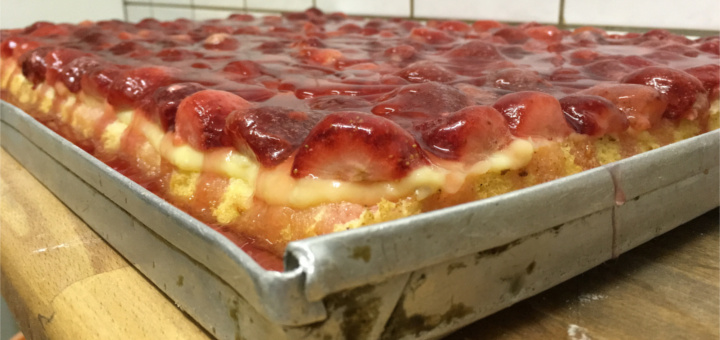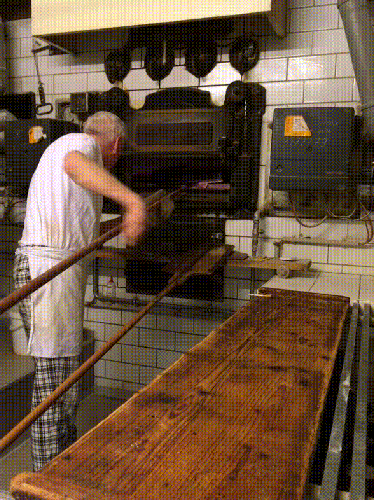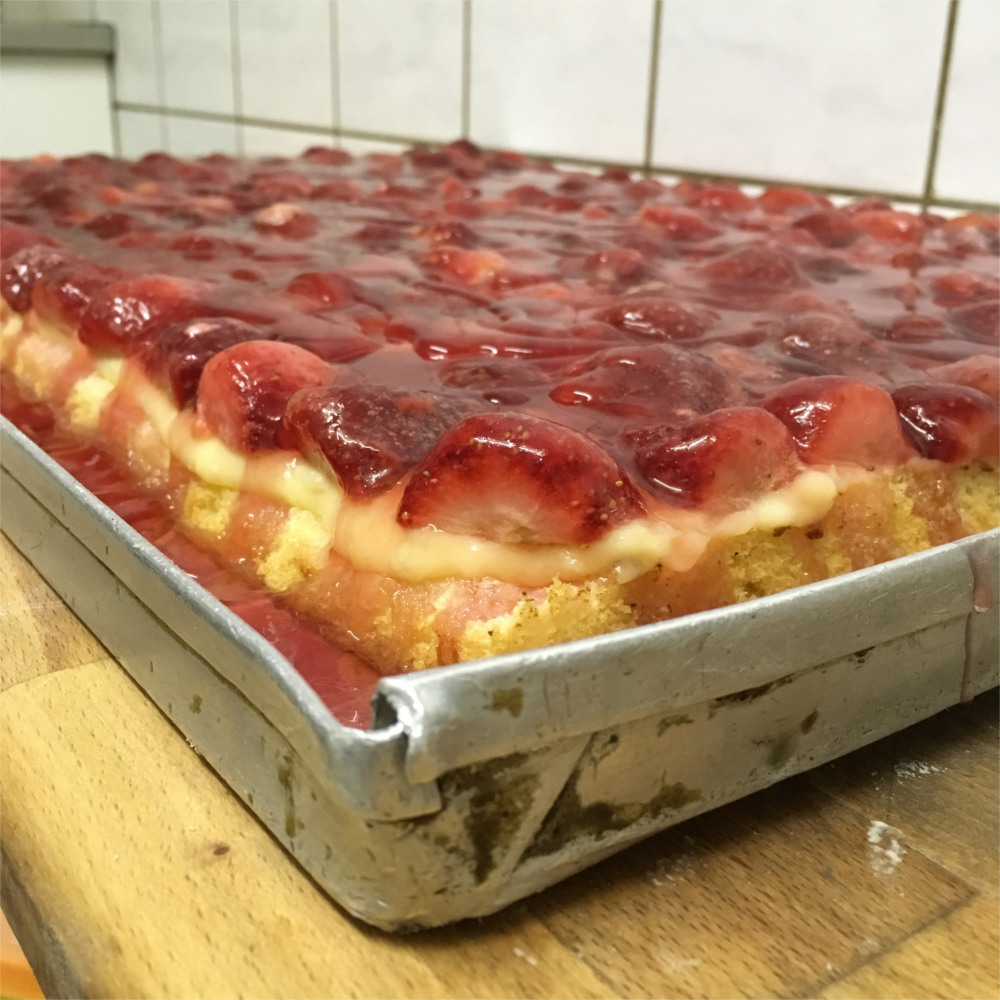Fresh from the Oven

After four months of working at the Erfurt bakery, they are starting to accept me as one of their own. I no longer need next step instruction; I am well-adjusted to the complex choreography of the night shift. And while the father-son combo have a great rhythm all their own, I have learned to step in time – even if it is sometimes simply getting out of the way.
 I continue to absorb all the information that is thrown at me, but it continues to be quite overwhelming at times – especially when we venture into new products. And I also make my share of mistakes along the way. However, I soldier on and spread crumbles like a boss, score rolls like it’s going out of style, and form loafs like my life depended on it.
I continue to absorb all the information that is thrown at me, but it continues to be quite overwhelming at times – especially when we venture into new products. And I also make my share of mistakes along the way. However, I soldier on and spread crumbles like a boss, score rolls like it’s going out of style, and form loafs like my life depended on it.
I am still in the process of working with some German trade schools in order to gain entry to a master baker program. The paperwork and discussions seem to stretching the weeks into months. In the meantime, I continue my efforts to make dough in Germany.
The New Pastries
With the arrival of Easter a couple weeks ago, the routine was thrown into disarray. While the typical wares were still to be made, we introduced the Osternring (tr. Easter Ring) into the mix. This was a twisted circle of a sweet dough, baked, sprinkled with almonds and then finished off with a painted, hard-boiled egg in its center. I did not get a chance to see the final product as the sales ladies were responsible for making all the goods look pretty.
When the task was first introduced, I was quite excited to show off my braiding skills; however, no such expertise was required.
Additionally, we also began to make Obstkuchen much more often. This again is a baked bottom layer (Biskuitmasse), topped with pudding, arranged with fruit (in this case halved strawberries), and then covered with gelatin. I have been trained that each berry needs to be fully inundated with gelatin in order to avoid the berries going bad. I had attempted this very type of cake at home with blueberries, and I failed miserably. A word to the wise, make sure you have an extra thick layer of pudding in order to avoid getting a soggy, soupy base.
The final excitement is the introduction of Ochsenaugen (tr., ox eyes). The description of these pastries is that of concentric circles. Excitedly, I clarified that it must be a rough translation of “bull’s eye” – a term for the center of a target. Nope, this does not translate as such in German. It seems to be an odd coincidence; I am now quite curious as to how the Ochsenaugen got their name.
These circular pastries begin with a base of Mürbeteig, which is the equivalent of a piecrust dough. Around the circumference, a ribbon of persipan is squeezed and a dollop of jam is placed at its center. This treat is then baked. Note that persipan is similar to marzipan, but apricot or peach kernels are used instead of almonds. Once out of the oven, the pastry is glazed. I attempted to make another ring of fondant, but that stuff flows everywhere.
The Mistakes
As one could imagine, waking up at midnight and starting to work at 1 AM leaves one with a bit of a foggy mind. The coffee is already brewed and waiting for me when I arrive; yet, I rarely have a minute to spare until at least 2:30 AM.
Generally, my mistakes are fairly harmless. I once forgot that the crumbles were only to cover half the cake, not the apple section. The owner saw the error, shrugged, and said that some people like crumbles on the apples. Another time, I had forgotten to add a layer of cinnamon; he ended up sprinkling it over the crumbles and gave me another now-patented shrug.

It behooves me to point out how different this internship is to ones of the past; mistakes are much more tolerated, and never has a voice been raised or an object thrown. It is a very “shit happens” environment. I have burnt my finger, and I have accidentally put my hand through a loaf while trying to keep it from falling. Each time, I am told that it will be fine; they will just use that loaf here. Hey, at least that loaf did not hit the floor…
The Breads
The Easter holiday also closed the bakery on many of my interning days, so I was offered the chance to come in on one of my off days. Thursday is Dinkelbrot day. Dinkel, which is also known as spelt grain, has a very different texture to it. While I am in charge of the daily production of Dinkel rolls, I am not a huge fan of how they taste. However, I did get the chance to taste one of the breads after observing their production; I find the added grain flakes make it much more delicious when compared to its roll-relative.
These 500 gram loaves are placed into these deep forms and pressed into place. When taken out of the oven, they resemble bricks in size and coloring. Just remember to well grease the forms; otherwise, that loaf will not be coming out of the form in one piece.
Forming loaves is a skill, one that I have not yet mastered. I have been trying to roll a 500 gram dough into a ball with one hand, asking questions about pressure and motion, but I am simply told that it comes with experience. One day it will all make sense. Still, we run through the three or four different bread doughs each morning and place them to rise next to the hot oven. Once risen, they are dumped out of their fermenting form and thrown in the oven.
 Along the way, there always seems to be special requests for bread or rolls or something called a party loaf. This loaf is a grouping of 30 (or so) white bread rolls with various toppings. The arrangement in a circular formation reminds me of the Settlers of Catan board game. I am informed that they key is to leave a bit of space when laying them out as the outside ring of rolls tend to be pushed outward as they rise.
Along the way, there always seems to be special requests for bread or rolls or something called a party loaf. This loaf is a grouping of 30 (or so) white bread rolls with various toppings. The arrangement in a circular formation reminds me of the Settlers of Catan board game. I am informed that they key is to leave a bit of space when laying them out as the outside ring of rolls tend to be pushed outward as they rise.
As of today, I am still waiting to hear more about the opportunity to begin classes to become officially recognized as a master baker. Each state in Germany has multiple trade schools and each school determines enrollment exceptions independently from others. As such, I have reached out to two schools and made my case for an exception to their normal processes. I hope to hear back soon and look forward to earning this designation as a culmination of my adventures here in Germany. For now, I continue to collect knowledge (and baking hours) for the master’s program.










I learned a lot from this blog entry. How a party loaf is made, and FINALLY: somebody told me the difference between Marzipan and Persipan!!! Thank you.